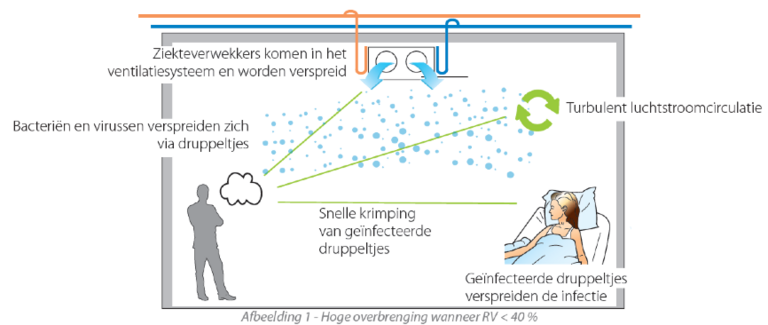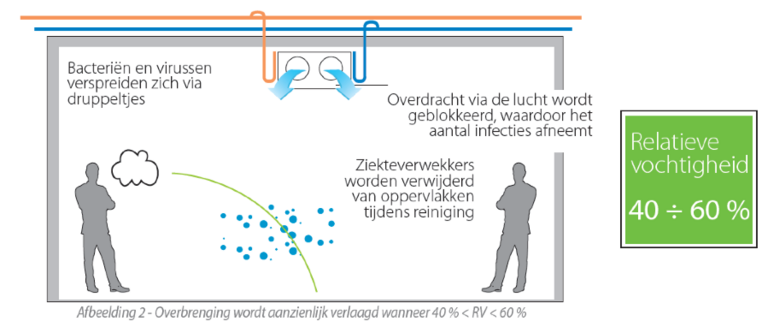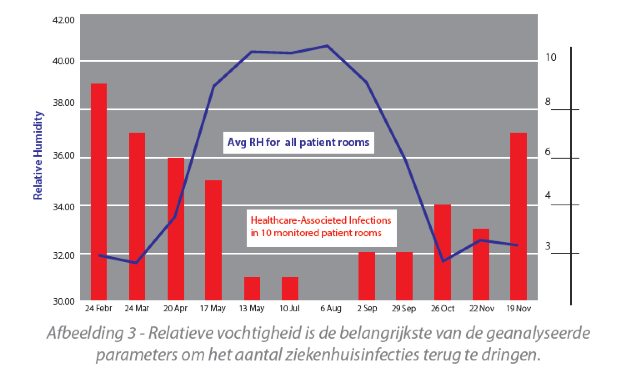Can we reduce the spread of viruses and bacteria, and if so, what should we pay attention to?

Spread of viruses and bacteria
Since its foundation in 1959, STULZ has developed in the Benelux into a leading global supplier for climate solutions. Precision cooling, air handling, comfort cooling, humidification and heat pumps, today it is no longer a question of which individual system to use, but rather what is the best overall solution for the task at hand. As a supplier of these types of climate solutions, we are sometimes faced with the question of how to solve or deal with this. Such is the case with the current COVID-19. pandemic.
We know that ventilation and air conditioning systems are an indispensable part of the climate control of many buildings. Therefore, regular maintenance and service are critical for safe system operation. Taking into account the current COVID-19 pandemic, operators of air handling units and air conditioning systems are faced with questions about the operation of the systems, some of which have not yet been clarified.
The German associations FGK, RLT manufacturers association and BTGA have summarized the current recommendations and are passing them on based on the state of knowledge at this time. As soon as more information becomes available, they will supplement this recommendation. See also: www.fgk.de/index.php
Ventilation and air conditioning systems, when properly designed and operated, reduce many pollutants by filtering potentially contaminated outside air, supply air and, where applicable, return air, thereby ensuring good quality supply air.
Professional planning, zoning and pressure maintenance ensure that pollutants from the exhaust air of one room cannot spread throughout the building.
Basic questions about the transmission of (corona) viruses:
According to current knowledge, (corona)viruses are transmitted by droplet infection, for example, through sneezing and coughing. These droplets, depending on the conditions in the room where this takes place, can spread many meters far and thus infect other persons. In principle, good ventilation of rooms with as high a proportion of outside air as possible is recommended.

Recommendations for safe operation of systems:
-
Do not turn off air handling systems operating with outside air, do not reduce the volume flows of outside air.
-
Reduce recirculated air, if applied in the systems, in favor of the proportion of outside air.
-
If necessary, extend the operating times of the systems before and after normal operating times.
-
Secondary air handlers (fan-coil units, induction units) are effective only in the respective individual room and do not transfer air to other rooms.
Transmission of (corona)viruses through air conditioning systems
According to current knowledge, the transmission of (corona) viruses through ventilation/air conditioning systems can in principle be excluded. Through filtration, droplets that may contain the (corona) virus cannot be introduced into rooms through outside air ducts and supply air ducts. Exhaust air ducts that extract droplet-contaminated exhaust air from rooms do not transport it to other areas because the systems operate with negative pressure so that no exhaust air can escape, even if the ducts leak. Depending on the design, leaks in the air handling unit and in the heat recovery unit (WTW) can cause a small portion of the exhaust air to be transferred to the supply air. Proper system design with modern concepts prevents this:
-
Overpressure in the supply air section compared to the exhaust air section: due to the arrangement of overpressure and underpressure areas, no relevant exhaust air can be mixed with the supply air, even by heat recovery systems such as heat wheels.
-
Als de toevoer- en afvoerluchtsystemen afzonderlijk zijn geplaatst, b.v. bij twin coil warmteterugwinnings-systemen, kan de overdracht van afvoerluchtdeeltjes naar de toevoerlucht worden uitgesloten.
Filtration
Air filters provide a relevant reduction of dust and aerosol concentration in air conditioning systems and in the supply air of rooms. HEPA filters are used for complete separation of suspended particles, even the smallest viruses (22-330 nm [nanometers]). Supply air filtered in this way is required in air treatment systems for clean rooms, operating rooms in hospitals or in special laboratories. Starting with filter class H-13, all substances containing viruses are completely separated. A noticeable reduction is already achieved by using filter class ePM1 ≥ 80% (old F9).
Filter maintenance
Viruses are always bound to aerosols or dust particles and therefore usually do not float freely in the room. They therefore accumulate in the filter material just like all other particles. Personal protective equipment should always be worn when maintaining and replacing loaded filters (protective cover, mouth/nose protection FFP3 and safety glasses).
Room and humidity
Room humidity can also play a role in virus transmission. Studies have shown that the transmission of flu viruses decreases at room humidity levels of 40 to 60%.

Whether this circumstance also applies to coronaviruses is not definitively known. If humidity control with the ventilation/air conditioning system is possible, it should be done as follows:
-
Room humidity should be maintained between 30 and 65% rv. A target of 40% for systems with humidification may be advantageous, in no case less than 35%, as dry air with <30% relative humidity carries a higher risk of infection.
-
For systems without humidification, it is important to consider what ventilation rates are appropriate under current occupancy levels.
So yes, we can reduce the spread of viruses and bacteria. Decades of experience combined with a constant drive for innovation is what makes STULZ unique. From engineers to customer consultants, we continuously work together to develop and optimize mission-critical solutions. In doing so, we also keep safety in mind especially under the current circumstances. We hope to contribute with this piece on how to reduce the spread of viruses (not only COVID-19) and bacteria but also how to create a healthier living and working environment.

Sources:
- Robert Koch Institute (RKI) / CCI: Should ventilation systems be switched off as a precaution against the transmission of COVID-19 ("corona viruses")?
The RKI answered: Since COVID-19 is an infection primarily spread via droplets (and not primarily transmitted via air), it cannot be assumed, based on the current state of knowledge, that SARS-CoV-2 will be further spread via operated ventilation systems (e.g. in public buildings, hotels). - COVID-19
Guidance for infection prevention and control in healthcare settings. Department of Health and Social Care (DHSC), Public Health Wales (PHW), Public Health Agency (PHA) Northern Ireland, Health Protection Scotland (HPS) and Public Health England as official guidance: - WHO, INTERIM GUIDANCE DOCUMENT Clinical management of severe acute respiratory infections when novel coronavirus is suspected: What to do and what not to do: Airborne precautions Ensure that healthcare workers performing aerosol-generating procedures use PPE, including gloves, long-sleeved gowns, eye protection and particulate respirators (N95 or equivalent). Whenever possible, use adequately ventilated single rooms when performing aerosol-generating procedures.
- Comment Prof. Dr. med. Dipl.-Ing. Hans-Martin Seipp
Technische Hochschule Mittelhessen 17.3.2020 Excerpt:
As a source for third parties, AHU systems can only work if:
A) Recirculated air travels WITHOUT HEPA filters (HEPAs are completely safe from H13 on!)
From F-9 - depending on the load condition - a reduction of the risk begins. B) brings too little air exchange into the room. - Air, Surface Environmental, and Personal Protective Equipment Contamination by Severe Acute Respiratory Syndrome Coronavirus 2 (SARS-CoV-2) From a Symptomatic Patient
JAMA Published online March 4, 2020 - Walter Hugentobler, MD, Comment on COVID-19 guidance, 23.03.2020
- Taylor S. (2016) “Breath easy: two basic steps to improve patient outcomes and healthcare reimbursement”.
- Taylor S., Hugentobler W. (2016) “Is low indoor humidity a driver for healthcare-associated infections?”.

